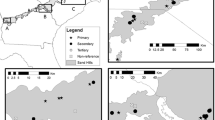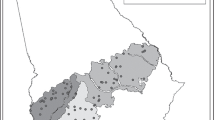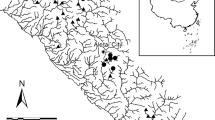Abstract
Identification of minimally disturbed reference sites is a critical step in developing precise and informative ecological indicators. We tested procedures to select reference sites, and quantified natural variation (inter-site and -annual variability) among reference conditions using a macroinvertebrate data set collected from 429 mediterranean-climate stream reaches in the San Francisco Bay Area, California (USA). We determined that a landscape GIS-based stressor screen followed by a local field-based stressor screen effectively identified least-disturbed reference sites that, based on NMS ordination results, supported different biological communities than sites identified with only landscape (GIS) or local (field) stressors. An examination of least-disturbed reference sites indicated that inter-site variability was strongly associated with stream hydrology (i.e., perennial vs. non-perennial flow) and annual precipitation, which highlights the need to control for such variation when developing biological indicators through natural gradient modeling or using unique biological indicators for both non-perennial and perennial streams. Metrics were more variable among non-perennial streams, indicating that additional modeling may be needed to develop precise biological indicators for non-perennial streams. Among 192 sites sampled two to six times over the 8-year study period, the biological community showed moderate inter-annual variability, with the 100 point index of biotic integrity scores varying from 0 to 51 points (mean = 11.5). Variance components analysis indicated that inter-annual variability explained only a fraction (5–18 %) of the total variation when compared against site-level variation; thus efforts to understand causes of natural variation between sites will produce more precise and accurate biological indicators.




Similar content being viewed by others
References
ABAG (2011) Association of Bay Area Governments. http://www.abag.ca.gov/. Accessed 3 August 2011
Bailey RC, Norris RH, Reynoldson TB (2004) Bioassessment of freshwater ecosystems: using the reference condition approach. Kluwer Academic, Boston
Barbour MT, Gerritsen J, Snyder BD, Stribling JB (1999) Rapid bioassessment protocols for use in streams and wadeable rivers: periphyton, benthic macroinvertebrates and fish, EPA 841-B-99-002, 2nd edn. Office of Water, U.S. Environmental Protection Agency, Washington, DC
Béche LA, McElravy EP, Resh VH (2006) Long-term seasonal variation in the biological traits of benthic-macroinvertebrates in two mediterranean-climate streams in California, USA. Freshw Biol 51(1):56–75
Bogan MT, Lytle DA (2007) Seasonal flow variation allows ‘time-sharing’ by disparate aquatic insect communities in montane desert streams. Freshw Biol 52:290–304
Bonada N, Rieradevall M, Prat N, Resh VH (2006) Benthic macroinvertebrate assemblages and macrohabitat connectivity in mediterranean-climate streams of northern California. J N Am Benthol Soc 25(1):32–43
Bonada N, Doledec S, Statzner B (2007) Taxonomic and biological trait differences of stream macroinvertebrate communities between mediterranean and temperate regions: implications for future climatic scenarios. Glob Change Biol 13(8):1658–1671
Bureau of Transportation Statistics (2002) 2002 National transportation atlas data (1:100,000 base scale) BTS-roads 1.0. Department of Transportation. http://www.bts.gov/gis/download_sites/ntad02/maindownload.html. Accessed 31 August 2008
Chaves ML, Costa JL, Chainho P, Costa MJ, Prat N (2006) Selection and validation of reference sites in small river basins. Hydrobiologia 573:133–154
Clarke RT, Hering D (2006) Errors and uncertainty in bioassessment methods: major results and conclusions from the STAR project and their application using STARBUGS. Hydrobiologia 566:439–443
Collier KJ (2008) Temporal patterns in the stability, persistence and condition of stream macroinvertebrate communities: relationships with catchment land-use and regional climate. Freshw Biol 53(3):603–616
Collier KJ, Haigh A, Kelly J (2007) Coupling GIS and mulitvariate approaches to reference site selection for wadeable stream monitoring. Environ Monit Assess 127(1–3):29–45
Dallas HF (2012) Ecological status assessment in mediterranean-rivers: complexities and challenges in developing tools for assessing condition and defining reference conditions. Hydrobiologia. doi:10.1007/s10750-012-1305-8
Doberstein CP, Karr JR, Conquest LL (2000) The effect of fixed-count subsampling on macroinvertebrate biomonitoring in small streams. Freshw Biol 44(2):355–371
ESRI (2005) ArcGIS 9.1. Environmental Systems Research Institute, Redlands
Feminella JW (1996) Comparison of benthic macroinvertebrate assemblages in small streams along a gradient of flow permanence. J N Am Benthol Soc 15(4):651–669
Fritz KM, Johnson BR, Walters DM (2008) Physical indicators of hydrologic permanence in forested headwater streams. J N Am Benthol Soc 27(3):690–704
Gasith A, Resh VH (1999) Streams in mediterranean climate regions: abiotic influences and biotic responses to predictable seasonal events. Annu Rev Ecol Syst 30:51–81
Gebler JB (2004) Mesoscale spatial variability of selected aquatic invertebrate community metrics from a minimally impaired stream segment. J N Am Benthol Soc 23(3):616–633
Gilbert B, Dillon PJ, Somers KM, Reid RA, Scott L (2008) Response of benthic macroinvertebrate communities to El Niño related drought events in six upland streams in south-central Ontario. Can J Fish Aquat Sci 65(5):890–905
Gilliam H (2002) Weather of the San Francisco Bay region, 2nd edn. University of California Press, Berkeley
Hannaford MJ, Resh VH (1995) Variability in macroinvertebrates rapid bioassessment surveys and habitat assessments in a Northern California stream. J N Am Benthol Soc 14(3):430–439
Harrington JM (1999) California stream bioassessment procedures. California Department of Fish and Game, Water Pollution Control Laboratory, Rancho Cordova
Hawkins CP, Norris RH, Hogue JN, Feminella JW (2000) Development and evaluation of predictive models for measuring the biological integrity of streams. Ecol Appl 10(5):1456–1477
Hawkins CP, Olson JR, Hill RA (2010) The reference condition: predicting benchmarks for ecological and water-quality assessments. J N Am Benthol Soc 29(1):312–343
Hellawell JM (1986) Biological indicators of freshwater pollution and environmental management. Elsevier Applied Science Publishers, New York
Homer C, Huang CQ, Yang LM, Wylie B, Coan M (2004) Development of a 2001 national land-cover database for the United States. Photogramm Eng Remote Sens 70(7):829–840. http://seamless.usgs.gov/. Accessed 1 August 2008
Hughes RM (1995) Defining acceptable biological status by comparing with reference conditions. In: Davies WS, Simon TP (eds) Biological assessment and criteria: tools for water resource planning and decision making. Lewis Publishers, Boca Raton, pp 31–47
JMP (2010) JMP. Version 9. SAS Institute Inc., Cary
Karr JR (1999) Defining and measuring river health. Freshw Biol 41(2):221–234
Kerans BL, Karr JR (1994) A benthic index of biotic integrity (B-IBI) for rivers of the Tennessee Valley. Ecol Appl 4(4):768–785
Lake PS, Schreiber ESG, Milne BJ, Pearson RG (1994) Species richness in streams: patterns over time, with stream size and with latitude. Int Ver fuer Theor und Angew Limnol Verh 25(3):1822–1826
Larsen DP, Kincaid TM, Jacobs SE, Urquhart NS (2001) Designs for evaluating local and regional scale trends. Bioscience 51(12):1069–1078
Lawrence JE, Lunde KB, Mazor RD, Béche LA, McElravy EP, Resh VH (2010) Long-term macroinvertebrate responses to climate change: implications for biological assessment in mediterranean-climate streams. J N Am Benthol Soc 29(4):1424–1440
Li J, Herlihy A, Gerth W, Kaufmann P, Gregory S, Urquhart S, Larsen DP (2001) Variability in stream macroinvertebrates at multiple spatial scales. Freshw Biol 46(1):87–97
Lorenz A, Kirchner L, Hering D (2004) ‘Electronic subsampling’ of macrobenthic samples: how many individuals are needed for a valid assessment result? Hydrobiologia 516(1):299–312
Mazor RD, Purcell AH, Resh VH (2009) Long-term variability in bioassessments: a twenty-year study from two Northern California streams. Environ Manag 43(6):1269–1286
McCune B, Grace JB (2002) Analysis of ecological communities. MjM Software Design, Gleneden Beach
McCune B, Mefford MJ (2011) PC-ORD multivariate analysis of ecological data. Version 6.0. MjM Software Design, Gleneden Beach
Milner AM, Conn SC, Brown LE (2006) Persistence and stability of macroinvertebrate communities in streams of Denali National Park, Alaska: implications for biological monitoring. Freshw Biol 51(2):373–387
Minshall GW, Petersen RC, Cummins KW, Bott TL, Sedell JR, Cushing CE, Vannote RL (1983) Interbiome comparison of stream ecosystem dynamics. Ecol Monogr 53(1):1–25
Munne A, Prat N (2011) Effects of mediterranean climate annual variability on stream biological quality assessment using macroinvertebrate communities. Ecol Ind 11(2):651–662
Needham PR, Usinger RL (1956) Variability in the macrofauna of a single riffle in Prosser Creek, California, as indicated by the Surber sampler. Hilgardia 24(14):383–409
Nichols SJ, Robinson WA, Norris RH (2006) Sample variability influences on the precision of predictive bioassessment. Hydrobiologia 572:215–233
Ode PR (2003) CAMLnet: list of California macroinvertebrate taxa and standard taxonomic effort. Unpublished report of the California Department of Fish and Game, Aquatic Bioassessment Laboratory, Rancho Cordova. http://www.safit.org/ste.html. Accessed 5 May 2009
Ode PR, Rehn AC, May JT (2005) A quantitative tool for assessing the integrity of southern coastal California streams. Environ Manag 35(4):493–504
Olsen AR, Peck DV (2008) Survey design and extent estimates for the Wadeable Streams assessment. J N Am Benthol Soc 27(4):822–836
Poff NL, Allan JD, Bain MB, Karr JR, Prestegaard KL, Richter BD, Sparks RE, Stromberg JC (1997) The natural flow regime. Bioscience 47(11):769–784
Poff NL, Richter BD, Arthington AH, Bunn SE, Naiman RJ, Kendy E, Acreman M, Apse C, Bledsoe BP, Freeman MC, Henriksen J, Jacobson RB, Kennen JG, Merritt DM, O’Keeffe JH, Olden JD, Rogers K, Tharme RE, Warner A (2010) The ecological limits of hydrologic alteration (ELOHA): a new framework for developing regional environmental flow standards. Freshw Biol 55(1):147–170
Pont D, Hughes RM, Whittier TR, Schmutz S (2009) A predictive index of biotic integrity model for aquatic-vertebrate assemblages of Western US streams. Trans Am Fish Soc 138(2):292–305
PRISM Climate Group (2010) Precipitation 800 m annual normals (1971–2000). Oregon State University. http://www.prism.oregonstate.edu. Accessed 5 July 2012
Rehn AC, Ode PR, May JT (2005) Development of a Benthic index of biotic integrity (B-IBI) for wadeable streams in northern coastal California and its application to regions 305(b) assessment. Technical report for the California State Water Quality Control Board. California Department of Fish and Game Aquatic Bioassessment Laboratory, Rancho Cordova. http://www.swrcb.ca.gov/water_issues/programs/swamp/docs/reportsfinal_north_calif_ibi.pdf. Accessed 20 October 2010
Rehn AC, Ode PR, Hawkins CP (2007) Comparisons of targeted-riffle and reach-wide benthic macroinvertebrate samples: implications for data sharing in stream-condition assessments. J N Am Benthol Soc 26(2):332–348
Resh VH (1979) Sampling variability and life-history features: basic considerations in the design of aquatic insect studies. J Fish Res Board Can 36(3):290–311
Resh VH (1994) Variability, accuracy, and taxonomic costs of rapid assessment approaches in benthic macroinvertebrate biomonitoring. Boll Di Zool 61(4):375–383
Resh VH (2007) Multinational, freshwater biomonitoring programs in the developing world: lessons learned from African and Southeast Asian river surveys. Environ Manag 39(5):737–748
Resh VH (2008) Which group is best? Attributes of different biological assemblages used in freshwater biomonitoring programs. Environ Monit Assess 138(1–3):131–138
Resh VH, Rosenberg DM (1989) Spatial–temporal variability and the study of aquatic insects. Can Entomol 121(11):941–963
Resh VH, Rosenberg DM, Reynoldson TB (2000) Establishing reference conditions in the Fraser River catchment, British Columbia, Canada, using the BEAST (Benthic assessment of sediment) predictive model. In: Wright JF, Sutcliffe DW, Furse MT (eds) Assessing the biological quality of fresh waters. Freshwater Biological Association, Ambleside, pp 181–194
Reynoldson TB, Bailey RC, Day KE, Norris RH (1995) Biological guidelines for freshwater sediment based on Benthic assessment of sediment (the BEAST) using a multivariate approach for predicting biological state. Aust J Ecol 20(1):198–219
Reynoldson TB, Norris RH, Resh VH, Day KE, Rosenberg DM (1997) The reference condition: a comparison of multimetric and multivariate approaches to assess water-quality impairment using benthic macroinvertebrates. J N Am Benthol Soc 16(4):833–852
Richards AB, Rogers DC (2006) List of freshwater macroinvertebrate taxa from California and adjacent states including standard taxonomic effort levels. Southwestern Association of Freshwater Invertebrate Taxonomists. http://www.safit.org/ste.html. Accessed 5 May 2009
Richter BD, Baumgartner JV, Powell J, Braun DP (1996) A method for assessing hydrologic alteration within ecosystems. Conserv Biol 10(4):1163–1174
Sanchez-Montoya MM, Suarez ML, Vidal-Abarca MR (2009a) Seasonal and interannual variability of macroinvertebrate reference communities and its influence on bioassessment in different mediterranean stream types. Fundam Appl Limnol 174(4):353–367
Sanchez-Montoya MM, Vidal-Abarca MR, Punti T, Poquet JM, Prat N, Rieradevall M, Alba-Tercedor J, Zamora-Munoz C, Toro M, Robles S, Alvarez M, Suarez ML (2009b) Defining criteria to select reference sites in mediterranean streams. Hydrobiologia 619:39–54
Sandin L, Johnson RK (2000) The statistical power of selected indicator metrics using macroinvertebrates for assessing acidification and eutrophication of running waters. Hydrobiologia 422:233–243
Scarsbrook MR (2002) Persistence and stability of lotic invertebrate communities in New Zealand. Freshw Biol 47(3):417–431
Soranno PA, Wagner T, Martin SL, McLean C, Novitski LN, Provence CD, Rober AR (2011) Quantifying regional reference conditions for freshwater ecosystem management: a comparison of approaches and future research needs. Lake Reserv Manag 27(2):138–148
Southerland MT, Rogers GM, Kline MJ, Morgan RP, Boward DM, Kazyak R, Klauda RJ, Stranko SA (2007) Improving biological indicators to better assess the condition of streams. Ecol Ind 7(4):751–767
Stoddard JL, Larsen DP, Hawkins CP, Johnson RK, Norris RH (2006) Setting expectations for the ecological condition of streams: the concept of reference condition. Ecol Appl 16(4):1267–1276
Townsend CR (1989) The patch dynamics concept of stream community ecology. J N Am Benthol Soc 8(1):36–50
U.S. Environmental Protection Agency (1996) Level III ecoregions of the Continental United States (revised from Omernik 1987). http://www.epa.gov/wed/pages/eoregions/level_iii_iv.htm. Accessed 10 December 2010
U.S. Geological Survey (1999) National elevation dataset (NED) 1/3 Arc seconds. EROS Data Center. http://gisdata.usgs.net/ned. Accessed 1 August 2008
Vannote RL, Minshall GW, Cummins KW, Sedell JR, Cushing CE (1980) River continuum concept. Can J Fish Aquat Sci 37(1):130–137
Whittier TR, Stoddard JL, Larsen DP, Herlihy AT (2007) Selecting reference sites for stream biological assessments: best professional judgment or objective criteria. J N Am Benthol Soc 26(2):349–360
Wiggins GB, Mackay RJ, Smith IM (1980) Evolutionary and ecological strategies of animals in annual temporary pools. Arch fuer Hydrobiol Suppl 58(1–2):97–206
Williams DD (2006) The biology of temporary waters. Oxford University Press, Oxford
Wright JF (1995) Development and use of a system for predicting the macroinvertebrate fauna in flowing waters. Aust J Ecol 20(1):181–197
Wright JF, Sutcliffe DW, Furse MT (eds) (2000) Assessing the biological quality of freshwaters: RIVPACS and other techniques. Freshwater Biological Association, Ambleside
Yates AG, Bailey RC (2010) Selecting objectively defined reference sites for stream bioassessment programs. Environ Monit Assess 170(1–4):129–140
Zar JH (1999) Biostatistical analysis, 4th edn. Prentice Hall, Upper Saddle River
Acknowledgments
We thank the following organization for contributing data: San Francisco Bay Regional Water Quality Control Board’s Surface Water Ambient Monitoring Program (SWAMP), Alameda Countywide Clean Water Program, Contra Costa County Clean Water Program, Contra Costa County Citizens Monitoring Program, Marin County Stormwater Pollution Prevention Program, San Mateo Countywide Water Pollution Prevention Program, Santa Clara Valley Urban Runoff Pollution Prevention Program, Sonoma Ecology Center, and the Institute for Conservation Advocacy Research and Education; K. Taberski, S. Moore, and N. White of the San Francisco Bay Regional Water Quality Control Board SWAMP designed and managed the monitoring program that collected much of the data; J. Harrington, P. Ode, A. Rehn at the California Department of Fish and Game’s Aquatic Bioassessment Laboratory managed field teams and laboratory technicians; P. Randall, K. Kerr, and L. Buchan at EOA managed the CalEDAS database. A Merenlender provided helpful comments on previous versions on the manuscript, and M. Engeln assisted with statistical efforts. K. Lunde acknowledges funding from the Environmental Protection Agency Science to Achieve Results (EPA STAR) program and the National Science Foundation Graduate Research Fellowship Program (NSF GRFP). Although the research described in the article has been funded wholly or in part by the U.S. Environmental Protection Agency’s STAR program, it has not been subjected to any EPA review and therefore does not necessarily reflect the views of the Agency, and no official endorsement should be inferred.
Author information
Authors and Affiliations
Corresponding author
Rights and permissions
About this article
Cite this article
Lunde, K.B., Cover, M.R., Mazor, R.D. et al. Identifying Reference Conditions and Quantifying Biological Variability Within Benthic Macroinvertebrate Communities in Perennial and Non-perennial Northern California Streams. Environmental Management 51, 1262–1273 (2013). https://doi.org/10.1007/s00267-013-0057-1
Received:
Accepted:
Published:
Issue Date:
DOI: https://doi.org/10.1007/s00267-013-0057-1




